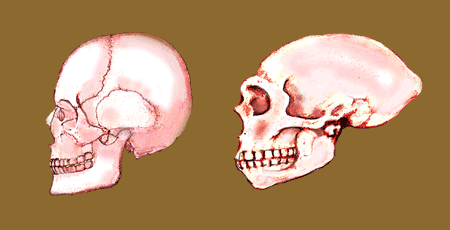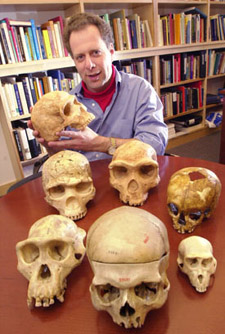Facing up to modern man
Evidence shows our brains and faces have gotten smaller


Daniel Lieberman can see millions of years of human evolution at a glance. The collection of skulls on his office shelves come from chimpanzees, long-extinct humans, and modern men and women. The hollow eye sockets, ancient teeth, and empty skulls pose the same question every day: What made us different from our archaic ancestors?
So far Lieberman has found some good answers and has come up with some controversial ideas.
“It has long been thought that our skulls are extremely different from those of our ancient ancestors,” says the Harvard professor of biological anthropology. “But it turns out that you don’t need to change many things to go from one skull type to the other. Just a handful of changes could shift the oblong, football shape of a Neandertal cranium to the rounded, soccer ball shape we see all around us today. Those changes would also move the face under the brain case, retracting the protruding face of our ancient ancestors and decreasing the size of their prominent brow ridge.”
These early alterations were followed by a steady decrease in human face and body size, which has been occurring over the past 10,000 years or so. As the severe climate of the ice ages ended, the bodies and faces of most large animals have gotten smaller. In humans, chewing softer, processed food also has contributed to reducing face size by decreasing the largeness of our jaws and jaw muscles. “Our faces are not only smaller than those of the first modern humans but also smaller than those of our ancestors’ who lived only 300 years ago,” Lieberman points out.
Modern humans differ from archaic humans in many respects, but anthropologists have been trying to define our species, Homo sapiens, based on the features of their skulls alone. That’s because skulls vary in obvious ways and many have survived as fossils. “The problem is that some skulls that are clearly modern don’t have all the modern features and a number of clearly archaic skulls have some of these features,” Lieberman notes.
He and his colleagues focus on crania, the skull minus the jaw. “We don’t look at differences in pelvises or jaws, for example, but what we have come up with is a simple pattern that is unique to modern humans.”
In your face
Lieberman, graduate student Brandeis McBratney, and postdoctoral fellow Gail Krovitz took CAT scans of 119 human skulls, ranging from modern men and women to those hundreds of thousands of years old. The scans provided three-dimensional images of the sites of skull growth, joints where individual bony plates that make up the skull come together.
Their analysis, published last month in the Proceedings of the National Academy of Sciences, showed only a few differences between modern skulls, and those of Neandertals and earlier human ancestors. The major change appears in the cranial base, the plate of bone that forms both the roof of our faces and the floor of our brain case. Lieberman shows its location by poking his finger through an empty eye socket and touching the bottom of that bony platform.
According to him, a sharper downward bend in the platform at a position near the temples makes modern skulls rounder than those of Neandertals and more ancient species. The flexion, which coincided with a forward extension of the cranial base, also moved faces under the front part of the brain and eliminated heavy brow ridges.
Getting a head
What caused these changes? No one has any samples of ancient brains to know for sure, but Lieberman and his colleagues believe that the alterations follow from an expansion of the temporal lobes of the brain, the areas that sit between the temples. “We think that an expansion of the soft brain tissue changes the shape of the hard skull bones, not the other way around,” notes McBratney. “The skull just goes along for the ride.”
The temporal lobes sit right where the cranial base of modern humans bends downward, so it makes sense to think that a growing brain is responsible for this and other shifts in the brain case.
Lieberman’s work suggests that modern humans have more voluminous temporal cavities than do their ancient ancestors. Besides containing a poker chip-size area responsible for hearing, these lobes handle functions related to memory and perception.
In front of the temporal lobes, behind the forehead, lie the frontal lobes, areas associated with organization, planning, decision making, and other behaviors allied with cognition and creativity. But frontal lobes have not gained much relative size in the millions of years of human evolution. “Your frontal lobes and those of chimpanzees are about the same size relative to the rest of the brain,” Lieberman notes.
How come? The answer is very complex. However, among other things, it involves changes in brain cells themselves, that is, in the development of more complex neural circuits and in the formation of new connections with other parts of the brain, such as the frontal lobes.
Neandertals had larger brains than we now do. But modern humans roaming around Africa and Europe 90,000 years ago had brains about the same size as Neandertals, albeit with larger temporal lobes. As mentioned previously, human brains and bodies have been getting smaller since the last ice age ended. However, Lieberman notes, the decrease in our brain size is relatively smaller than that of our faces. The latter still goes on.
Cultural ‘big bang’
Anthropological, biological, and genetic evidence all put the origin of modern humans at between 200,000 and 100,000 years ago, probably in Africa. There is also much data that show an outburst of cultural behavior occurring around 50,000-40,000 years ago in Europe. That’s when archaeologists date the oldest evidence of burial ceremonies, body ornaments, and cave paintings. What was going on during the 100,000 years or so between the anatomical and cultural revolutions?
Lieberman doubts that such a great gap exists. “When archaeologists find the first evidence for something, that doesn’t mean that’s when it first occurred,” he says. Lately, new examples of human craft and culture, found in Africa, have been dated to 70,000 years ago. Earlier examples of cultural evolution may well be found, and some cultural behaviors leave no evidence. “We can’t find the remains of the first songs and dances,” Lieberman points out. “And many subsequent revolutions in behavior, such as the beginnings of agriculture, weren’t associated with major changes in the form and structure of the cranium.”
The appearance of a rounded skull and retracted face is repeated today during the development of children in the womb and early infancy. Nevertheless, Lieberman’s theory that profound changes in the shape of our heads come from only a few shifts in cranial growth remains controversial, especially his theory about how an increase in temporal-lobe size impacted our origins.
“Everything in human evolution is controversial,” he comments. “Most of my colleagues have viewed the origins of our oddly shaped heads as a complex event involving lots of changes. Therefore, many people out there will be trying to figure out if and how I’m wrong. My colleagues and I, on the other hand, will be hard at work testing our ideas more fully. That’s how science works.”
My face I don’t mind it/Because I’m behind it.
– A. Euwer




